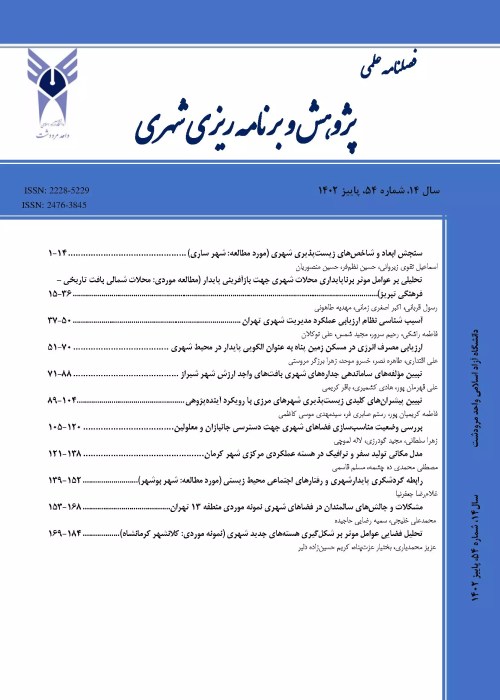The Assessment of Socio-cultural Structure of the City with an Urban Sustainable Development Approach (Case Study: City of Karaj)
Abstract:
In contemporary capitalism، city is considered as an appropriate location and urbanization as a favourable way of life. The penetration and influence of capitalism as a culture in the Third World، including Iran has caused heterogeneous urban concentration and rapid urban population growth and thereby، massive rural-urban migrations. In fact، a process that causes the immifration of mainly poor population to the cities. Clear example of such confrontation can be seen in the old textures and also in rural areas and towns like Karaj City. Karaj due to the its specific location of communication facilties route، and being located at highway linking to the west of the country as well as vicinity to Tehran and having environmental potentials besides factories and industrial areas in one hand، and rapid urbanization processes in the country، changing consumption patterns and the development of exogenous communities of the country، alongside massive influx of refugees from surrounding towns and villages on the other hand، has been the tangible outcome of this influx of urban crises being created due to numerous problems including the formation and development of marginalized communities، poor، high damage and social disorder، loss of quality of life and lack of minimum facilities and services required for biological life in an urban area. Variability and lack of sense of belonging، social capital links to the lack of viable neighborhood، with no coherence of ethnic diversity and social integration، all together have increased poverty and two-level divisions (of poverty and richness) within the Metropolitan of Karaj. In this paper، socio-cultural structure of the city of Karaj has been evaluated using SWOT technique. According to research findings، properly obtained strengths and opportunities in order to overcome weaknesses and threats have not been used. The strengths، weaknesses and threats in opportunities are dominant and a type of strategy، (contingency) diversity strategies، has been indicated. At the end، priorities QSPM matrix based on strategies has been suggested.
Keywords:
Language:
Persian
Published:
Research and Urban Planning, Volume:3 Issue: 9, 2012
Pages:
55 to 76
magiran.com/p1068178
دانلود و مطالعه متن این مقاله با یکی از روشهای زیر امکان پذیر است:
اشتراک شخصی
با عضویت و پرداخت آنلاین حق اشتراک یکساله به مبلغ 1,390,000ريال میتوانید 70 عنوان مطلب دانلود کنید!
اشتراک سازمانی
به کتابخانه دانشگاه یا محل کار خود پیشنهاد کنید تا اشتراک سازمانی این پایگاه را برای دسترسی نامحدود همه کاربران به متن مطالب تهیه نمایند!
توجه!
- حق عضویت دریافتی صرف حمایت از نشریات عضو و نگهداری، تکمیل و توسعه مگیران میشود.
- پرداخت حق اشتراک و دانلود مقالات اجازه بازنشر آن در سایر رسانههای چاپی و دیجیتال را به کاربر نمیدهد.
In order to view content subscription is required
Personal subscription
Subscribe magiran.com for 70 € euros via PayPal and download 70 articles during a year.
Organization subscription
Please contact us to subscribe your university or library for unlimited access!


